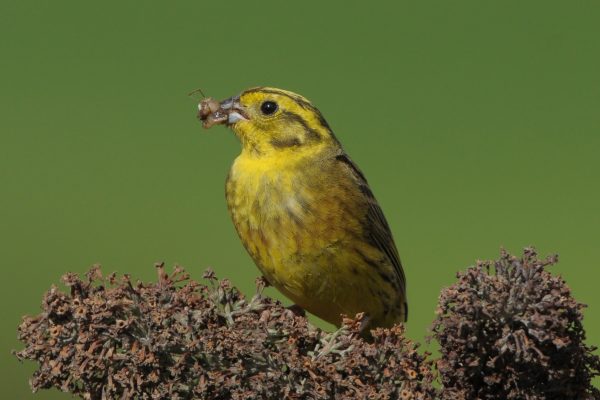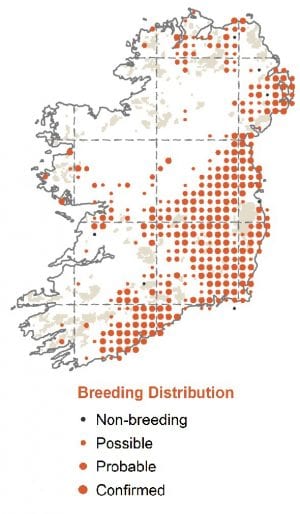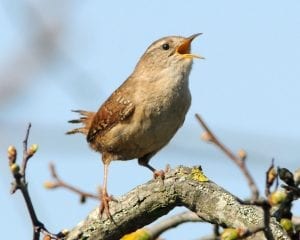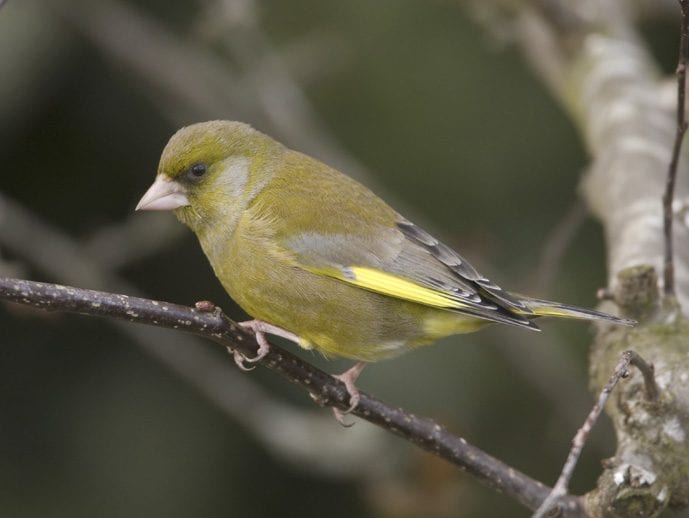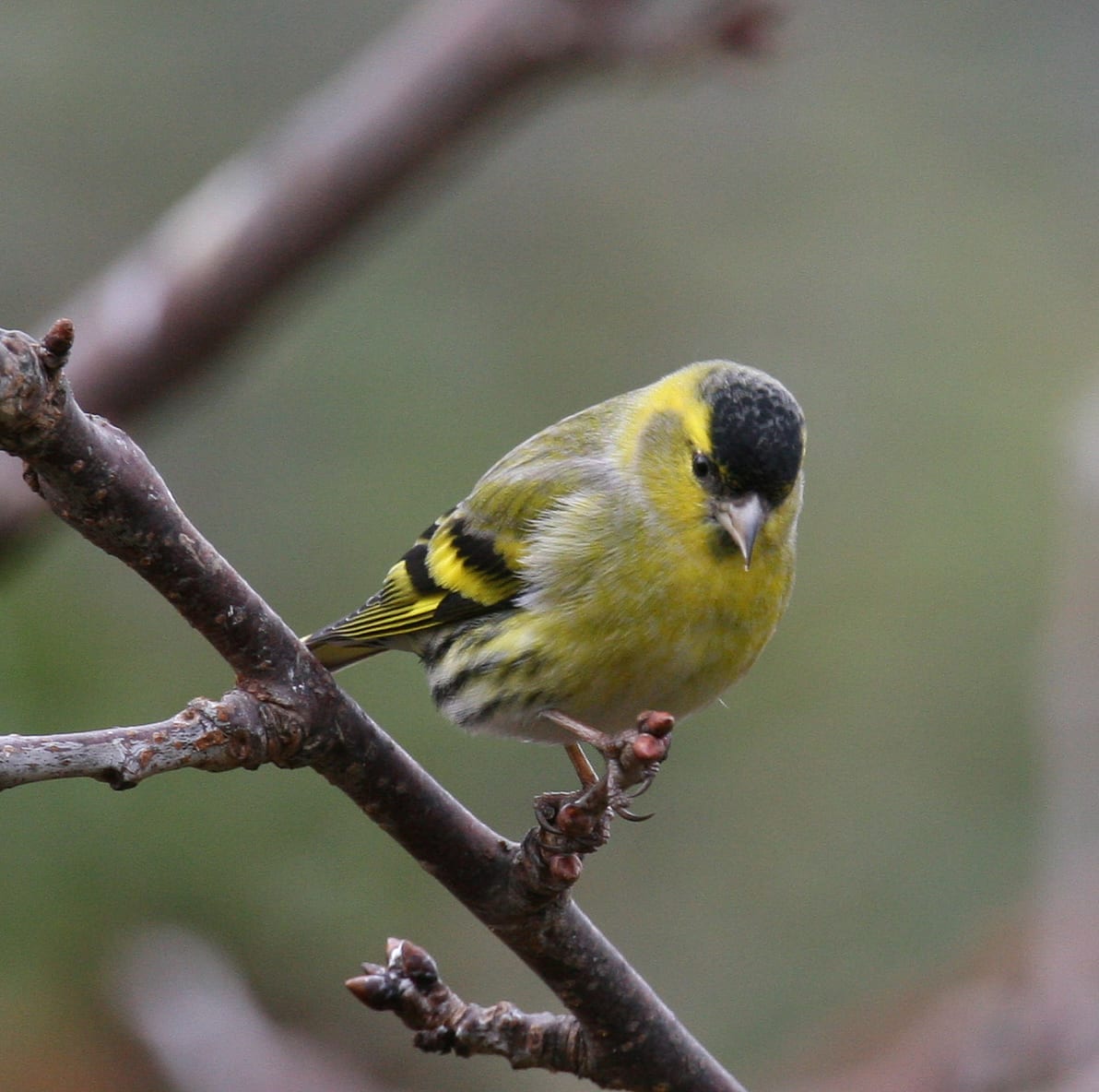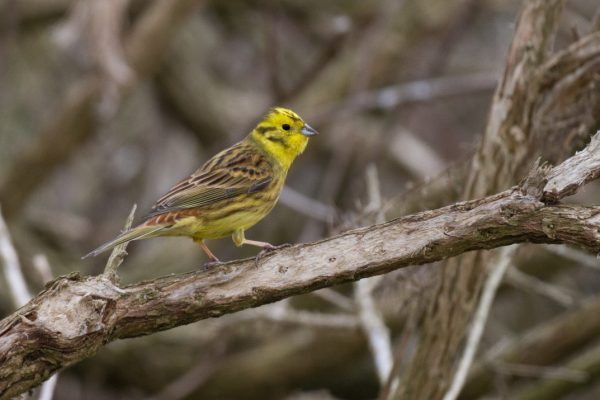
Yellowhammer
| Irish Name: | Buíóg |
| Scientific name: | Emberiza citrinella |
| Bird Family: | Buntings |
red
Conservation status
Conservation status
Status
Declining resident mainly in the east and south of Ireland. Strongly tied to cereal cultivation.
Identification
A typical bunting in size and shape (slightly larger than Chaffinch). Adult summer males are a stunning yellow colour on the head and underparts, appearing unlike any other Irish breeding bird species. Has an indistinct reddish-brown breast band and some faint black streaking along the flanks. The back and wings are brown with extensive black streaking. The rump is reddish-brown. Adult winter male Yellowhammers are much darker, with extensive black markings on the head and obvious black streaking on the breast. The head and underparts have an obvious yellow tint to them. Adult females resemble winter males, but have much less yellow on the head and underparts. Juveniles have a dark grey-brown head with an obvious white eyering.
Voice
Has several rather faint calls, which resemble those of Reed Bunting - "ziu", "plit", "pschiu". Males sing from an exposed perch in the top of a tree or hedgerow from spring to late summer. The song is a frequently repeated "sri-sri-sri-sri-sri-zu", initially increasing in pitch, before descending on the last note.
Diet
Feeds on grains of grasses and cereals. Young are fed insects.
Breeding
Formerly a widespread breeding species in Ireland, now restricted mainly to the east and south. Strongly linked with the cultivation of cereals and has declined in areas where these are no longer grown.
Wintering
Largely resident, though flocks may form in favoured feeding areas, such as winter stubble fields.
Monitored by
Blog posts about this bird
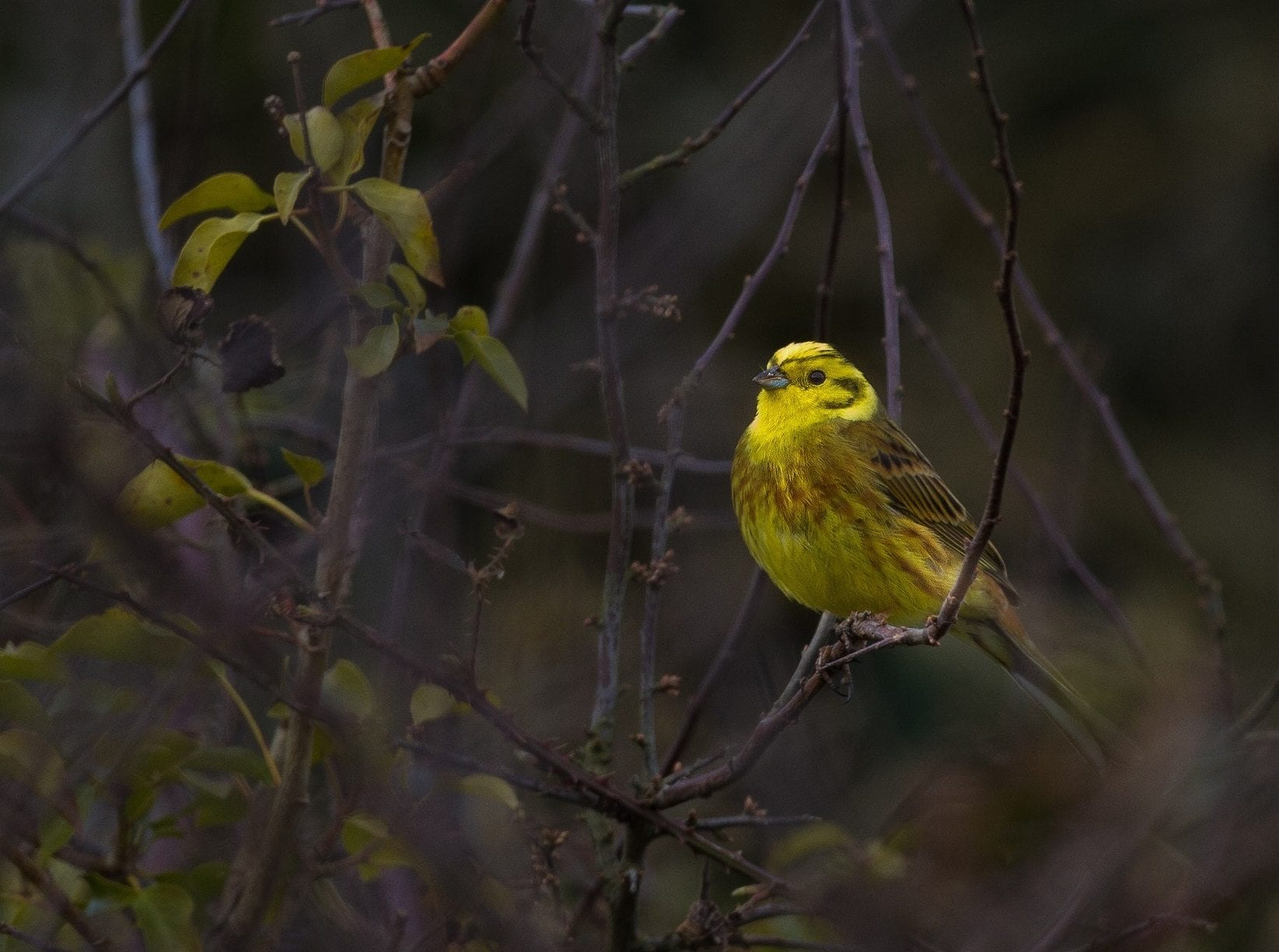
Nesting Season 101 – Hedge-cutting and the Law
Birds in Ireland are facing pressures from all sides, with habitat loss and fragmentation, predation, disturbance and climate change just some of the things they have to contend with. Nesting birds and their young are particularly vulnerable and, while it is vital that we don’t interfere with wild birds at this time, there are some things you can do to support birds during nesting season. One of the easiest ways to do so is to abide by existing laws around hedge-cutting and vegetation burning.
Hedge-cutting and vegetation burning ban
Under the Wildlife Act, it is against the law to cut, burn or otherwise destroy vegetation including hedges between March 1st and August 31st. The purpose of this ban is to prevent the disturbance and destruction of nesting sites of many of our wild bird species.Hedge-cutting
Hedges provide important nesting sites for many wild birds – including Robin, Wren, Blackbird, and Dunnock, to name a few – as well as a bounty of food for a variety of other species. They also offer shelter and safe routes for wildlife to travel along, known as wildlife corridors. Hedges offer numerous benefits to humans including food, natural property boundaries, shelter for crops and livestock, noise reduction and visual appeal. As healthy hedges also sequester and store atmospheric carbon, and help to slow water movement and prevent flooding, they are absolutely vital in mitigating the effects of climate change. The annual ban on hedge-cutting applies to private gardens as much as it does to farms and the wider countryside. While some green-fingered folk may argue that, with a steady hand, they can leave a nest unshaken, the sheer act of getting that close to the hedge and nests within it could be enough for the adult birds to abandon it. Without their parents, the eggs and chicks in the nest have virtually no hope of survival. If they don’t succumb to starvation due to lack of food delivery by an adult bird, they are likely to be victims of predation. 63% of regularly occurring Irish birds are of serious conservation concern, with 26% of them now Red-listed species of conservation concern and 37% Amber-listed species of conservation concern. With the decline in bird populations directly linked to the loss and degradation of habitat, it is important that we do all we can to preserve what remains. You can play your part in this by leaving your hedges alone during the nesting season, and by spreading the word to others.Wren. Photo: Michael Finn.
Vegetation Burning
The Wildlife Act also prohibits the burning of vegetation during the nesting season. This is aimed at protecting our ground-nesting bird species in upland habitats, many of which have seen their populations plummet in recent decades. This includes species such as Curlew, Lapwing, Skylark, Meadow Pipit and Hen Harrier. While burning is not the only cause of the decline of these species, it does pose a significant threat to their breeding success when carried out during the nesting period. But even during the 'open season' for burning, out-of-control fires, can have devastating consequences on habitats sometimes 'melting' peat soils due to the heat and destroying their functions as carbon stores and sinks as well as habitats for wildlife, for years. Illegal fires during the closed period can lead to the destruction of nests and young of these already vulnerable species, as well as the disturbance of breeding adults. Additionally, such burning can damage habitats that are protected in their own right such as Raised Bog and Blanket Bog. In addition to being unique and biodiverse habitats, our bogs serve as carbon sinks, meaning that they play a huge role in mitigating the effects of climate change.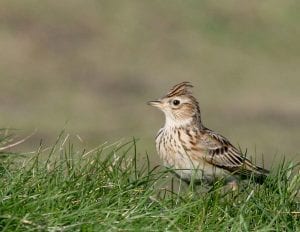
Reporting illegal cutting and burning
Despite the ban on hedge-cutting between March 1st and August 31st, it is possible that you will come across cutting and burning during this period. Indeed, the Wildlife Act does have exemptions which allow hedge-cutting during the closed period, for example, should there be road safety concerns. In saying this, regardless of who is involved, don’t assume that those cutting the hedge have received the green light to do so. It may well be that they are breaking the law. If you witness hedge-cutting or burning in any place or at any time during this period, please report it to the local Gardaí and the National Parks and Wildlife Service (NPWS). You can read the NPWS guidance on reporting Wildlife Crime here and find contact details for your local NPWS Wildlife Ranger here.Enforcement of the Wildlife Act
Efforts to tackle wildlife crime in Ireland have been strengthened in recent times. Forty-three prosecution cases were initiated by NPWS in 2023 for alleged breaches of wildlife legislation, a 39% increase since 2022. Wildlife crimes reported range from the disturbance of bats, illegal hunting, damage to Special Areas of Conservation (SACs), destruction of hedgerows and burning of vegetation within the restricted period, and more. This increase in action against wildlife crime is very much welcomed by us at BirdWatch Ireland. However, there is still work to be done. It is widely known that our wildlife legislation is not as strongly enforced as it could be, and that the initiation of cases and rates of conviction are higher in some locations than others. There are a number of reasons for this including a general lack of training and resources in the area of wildlife crime in both the National Parks and Wildlife Service (NPWS) and An Garda Siochána, and difficulty in gathering sufficient evidence on certain forms of wildlife crime. With this in mind, if you witness any other form of wildlife crime, or simply are worried about the situation for wildlife in this country, we would encourage you to also contact your local and national elected representatives to voice your concerns.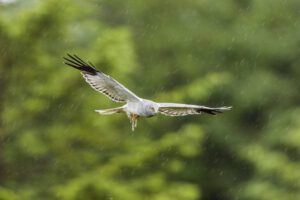
Early and Late Nesting Birds
While the ban on cutting and burning begins in March and will be lifted at the beginning of September, we strongly encourage you to leave your hedges for longer than the closed period. Unlike humans, birds don’t use calendars to determine their schedules! As the subject is understudied here, much of what we know about nesting is derived from UK data. However, owing to our milder climate, we likely have a potentially earlier onset to the nesting season in Ireland. Climate change has also caused a shift in birds' annual cycles, with milder temperatures leading some species to nest earlier in the year. We do have evidence of late nesters including the Red-listed Yellowhammer, the species with the latest fledging date. While the current legislation permits hedges to be cut from September 1st, at this time, approximately 5% of Yellowhammers may still have chicks in the nest. Hen Harrier may also still have unfledged chicks in the nest into late September. Until we have data on nest-building periods in Ireland, we advocate for a cautionary approach when it comes to hedgerow management and vegetation burning, particularly during these fringe periods.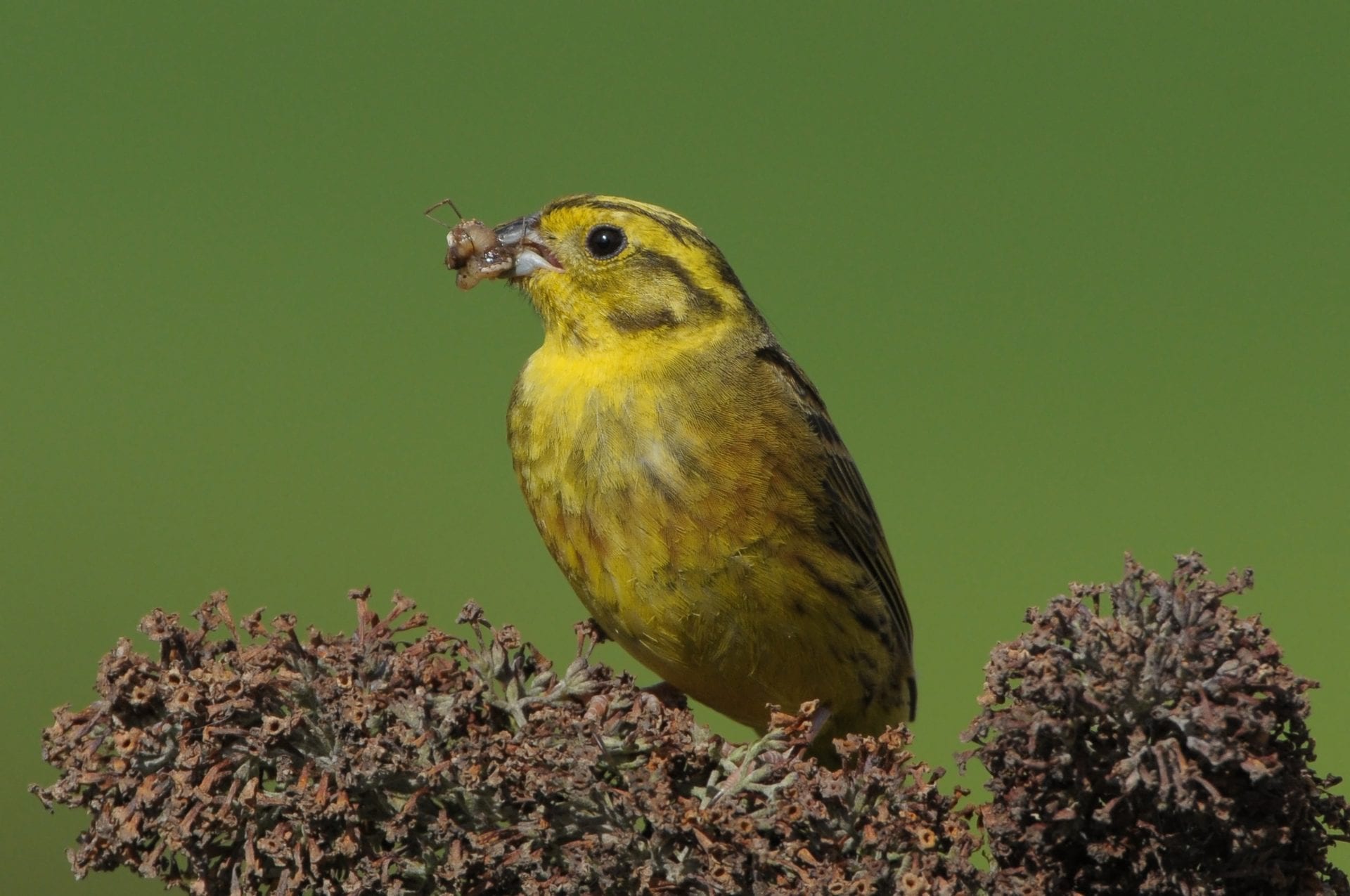
BirdWatch Ireland welcomes State purchase of Dowth Estate and establishment of Ireland's seventh National Park
BirdWatch Ireland welcomes the news of the State’s purchase of Dowth Hall demesne in County Meath and the establishment of the 500-acre property as a new National Park.
On Friday, Minister for Housing, Local Government and Heritage, Darragh O Brien TD confirmed the State’s purchase of the World Heritage lands of Dowth Hall and demesne, along with the establishment of a new National Park – the Boyne Valley (Brú na Bóinne) National Park.
A cultural and natural heritage site of national and international importance, the demesne includes Dowth Hall, an eighteenth-century neoclassical country house, and Netterville Manor, a late Victorian almshouse. The lands amount to approximately one-third of the total area of the UNESCO World Heritage Property of Brú na Bóinne, which includes the great Neolithic passage tombs of Newgrange, Knowth and Dowth.
The purchase paves the way for the establishment Ireland’s seventh National Park. It is the second National Park to be established in the east of the country alongside Wicklow Mountains National Park.



Grey Partridge. Photo: Colum Clarke.
Dowth has been actively managed by Devenish Nutrition over the last decade to preserve its cultural heritage and biodiversity. As well as their position within the Brú na Bóinne World Heritage Property, the Dowth lands are important places for nature. They host a wide range of habitats, including species-rich grasslands, native woodlands and mature hedgerows. The Boyne River which runs through the lands is designated as a Special Area of Conservation (SAC) under the Habitats Directive, and as a Special Protection Area (SPA) under the Birds Directive. Following the State purchase, the National Parks and Wildlife Service (NPWS) will maintain the careful management of the farmlands, habitats and species to date and will work to protect and improve it even further. The new Boyne Valley (Brú na Bóinne) National Park is rich in bird life. 54 species of birds have been recorded at the site including Red-listed species of conservation concern such as Grey Partridge, Woodcock, Kestrel, Swift and Yellowhammer. 19 species recorded at the site are on the Amber list, including Kingfisher, Common Sandpiper, Cormorant and Little Grebe. Dowth is also a haven for other wildlife and plants. The River Boyne is of national importance for a number of species of bat including Common Pipistrelle, Soprano Pipistrelle, Natterer's Bat, Brown Long-eared Bat, Leisler’s Bat, Whiskered Bat, Daubenton’s bat and Nathusius’ Pipistrelle. It also hosts many species of butterfly including Small Tortoiseshell, Ringlet, Holly Blue, Peacock, Meadow Brown, Speckled Wood, Large White, Green-veined White, Small White, Red Admiral and Painted Lady. While surveys have not been completed, it is likely that a large population of macro-moths (of which there are over 800 species) occur within managed habitats. Seven species of bee have also been recorded here including White-tailed Bumblebee, Honey Bee, Common Carder Bee, Garden Bumblebee, Early Bumblebee, Red-tailed Bumblebee and Buff-tailed Bumblebee.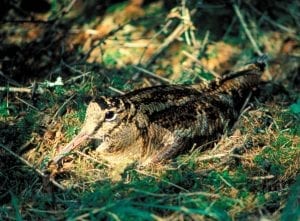
Woodcock on the nest. Photo: Richard T Mills
Minister for Housing, Local Government and Heritage, Darragh O’Brien TD welcomed the significant purchase and highlighted the many opportunities it could bring. “Rarely does the State get an opportunity to acquire lands of such significance. This landscape and property is of exceptional heritage importance. Here in this one place, we have over 5000 years of recorded history. In our care, it will significantly enhance our management of the Brú na Bóinne World Heritage landscape. We will conserve and protect Dowth’s heritage in line with our obligations to UNESCO and we will enhance responsible tourism, ensuring it becomes a standout destination. This purchase opens up possibilities for us to develop heritage partnerships, protect remarkable heritage and make it accessible. It is simply an outstanding opportunity for an outstanding place.” Minister of State with responsibility for Heritage and Electoral Reform, Malcolm Noonan TD said that the purchase represented an “outstanding addition to Ireland’s family of National Parks”. “We look forward to sustaining and growing this legacy to ensure that farming, nature and the cultural heritage of this ancient landscape can continue in harmony, as they have done since our ancestors first settled in the Boyne Valley over 5,500 years ago. Through our partnerships with state agencies, departments, local authorities and communities – which are enshrined in Heritage Ireland 2030, our national heritage plan – we are committed to nurturing Dowth as a key pillar of Ireland’s remarkable heritage that we can all admire, be proud of and enjoy.” The National Parks and Wildlife Service (NPWS), the National Monuments Service and the Office of Public Works (OPW) will now work together to deliver a Masterplan for the property that allows for the protection, presentation and management of this area of the Boyne Valley. Management of Dowth Hall and lands will form part of the existing Brú na Bóinne Management Plan and strengthen the vision for the protection of Dowth’s remarkable heritage, including the Neolithic passage tomb discovered in 2017 under Dowth Hall itself. “The work begins now of developing a Masterplan for Dowth. We will approach this with a keen sense of responsibility, ambition and excitement, knowing that this is a remarkable opportunity for Ireland’s heritage to play a lead role in the regional economy and in place-making for the east of the country,” said Niall O Donnchu, Director General of National Parks and Wildlife Service. “This new National Park is a special place where history, heritage, nature and culture collide. We will work with stakeholders in developing a Masterplan that will deliver on its full potential for locals, visitors and generations to come. I want to pay tribute to our team across the National Parks and Wildlife Service and the National Monuments Services for their work on this acquisition, and on their readiness to take over custodianship of this remarkable place from Devenish who have championed and maintained it with such care over the last 16 years.”

